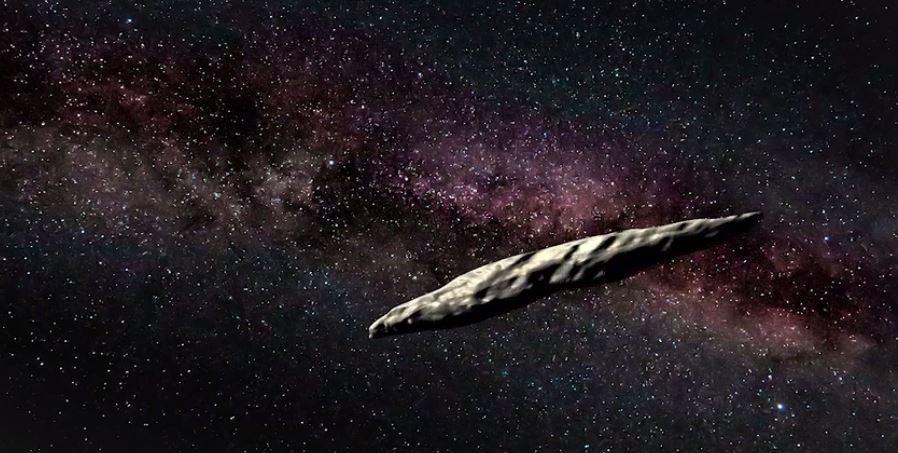The first-ever known interstellar object known to mankind — Oumuamua that was discovered back in 2017 for the first time, had violent past, reveals a new study. As per the latest research, the cigar-shaped object is part of a larger body that disintegrated millions of years and traveled in our Solar System. Researchers further revealed that the disintegration occurred when the parent body came closer to its star and due to massive gravitational forces, Oumuamua was torn apart from the larger body.
Oumuamua was spotted on Oct. 19, 2017 by the University of Hawaii’s Pan-STARRS1 telescope, funded by NASA’s Near-Earth Object Observations (NEOO) Program, which finds and tracks asteroids and comets in Earth’s neighborhood. At first, scientists classified it as a comet but later on, it showed properties of asteroids after it slingshotted past the Sun on Sept. 9, 2017 at a blistering speed of 196,000 miles per hour (87.3 kilometers per second).
Its name originated from a Hawaiian term which means messenger or scout. Yes, it is the first space interstellar which has been recognized as the forming around the other star.
Initial observations revealed that the interstellar Oumuamua is a rocky object that measures nearly 400 meters in length and is 40 meters wide. Such a shape is very unusual as no comets or asteroids in our solar system exist with such elongated dimensions.
“For decades we’ve theorized that such interstellar objects are out there, and now―for the first time―we have direct evidence they exist,” said Thomas Zurbuchen, associate administrator for NASA’s Science Mission Directorate in Washington. “This unusually big variation in brightness means that the object is highly elongated: about ten times as long as it is wide, with a complex, convoluted shape,” said Zurbuchen. “We also found that it had a reddish color, similar to objects in the outer solar system, and confirmed that it is completely inert, without the faintest hint of dust around it.”
The spinning action of the asteroid observed by the scientists dictated that the object was involved in a collision at some point of time. However, the actual origin of the object is still under study. The latest study has introduced three new possibilities for the origin story which is still being reviewed.
From the three possibilities, the first suggests that the object arrived from the outer periphery of our solar system which is close to the Kuiper Belt. The asteroid must have been hit by an unknown body in the space to achieve the speed needed to fling past the sun. However, according to lead author of the paper, Simon Zwart from the Leiden Observatory, such encounter with space objects is fairly rare.
According to the second possibility, the object approached our solar system from a star termed TYC4742-1027-1 which is located close. As per results derived from computer simulations, this object flew close to the star around 1.3 million year ago. But, when the speed of the asteroid is taken into account, it is highly unlikely that it came from any Oort clou present close to the star. It must have simply passed along the location of the star.
The last possibility is the most feasible one but it also suggests that the actual origin of the object might never be known to us. Scientists believe that any galaxy is surrounded by many flying objects that are similar to asteroids which mean the Oumuamua is also a part of the same field outside the galaxy.
This means that the asteroid might have ejected from its original solar system around thousands of millions years ago. The astronomers have estimated that the asteroid is here to stay close to our solar system for 20,000 years as per the trajectory but after that, it shall proceed towards its journey to Pegasus which is a constellation. These interstellar things are termed as sola lapis which roughly translates to “Lonely rock” in Latin.
For the new study led by Zhang and study co-author Douglas Lin, an astronomer at the University of California, Santa Cruz, took help of computer simulations and found out that very close encounters of planets with its star can rip these bodies into elongated fragments, which are then ejected into interstellar space. During close flyby, these elongated bodies extreme heat and once rejected from the system, they witness extreme cold. Such a huge variation in temperature leads to formation of solid crust which further helps in maintaining the elongated shape.
“Heat diffusion during the stellar tidal disruption process also consumes large amounts of volatiles, which not only explains ‘Oumuamua’s [reddish] surface colors and the absence of visible coma but also elucidates the inferred dryness of the interstellar population,” Zhang said. (“Volatiles” are elements and compounds that are easily lost to space, such as water.)
“Nevertheless, some high-sublimation-temperature volatiles buried under the surface, like water ice, can remain in a condensed form,” he added. These hidden volatiles could be “activated” during encounters with other stars like our sun, causing outgassing and non-gravitational acceleration, the researchers said.
Another study previously claimed that the mysterious interstellar asteroid Oumuamua might be possessing water in its interior in the form of ice. As per the latest research, water might be trapped beneath a thick carbon-rich organic coating present on its surface. This indicates that the odd-shaped object might possess ice inside it just like a comet and is covered with thick layer of crust.
Hence, the researchers believe that Oumuamua has natural origins and this water ice might have come from a star present beyond our solar system. Lead author of the study Alan Fitzsimmons from the Queen’s University Belfast, Northern Ireland explained that just like our own solar system has more icy stuffs than rocky stuffs, other solar systems might also possess objects that are icy in nature and that is why they doubt Oumuamua to possess water ice inside it.
“We know that our solar system has ejected many more icy bodies then rocky bodies,” said Fitzsimmons. He informed that when our solar system was formed, many gaseous and icy planets were formed near the outer edges of the solar system. These planets ejected trillions of objects. Some icy objects were pulled by other outside stars due to gravitational disruption. Hence, scientists believe that this Oumuamua might be one of those icy interstellar objects that possess the character of a comet.
According to the astronomers, find of Oumuamua is just the beginning as there might be billions of such interstellar wanderers in our solar system. “On average, each planetary system should eject in total about 100 trillion objects like ‘Oumuamua,” Zhang said.
The study appeared in the journal Nature Astronomy.

